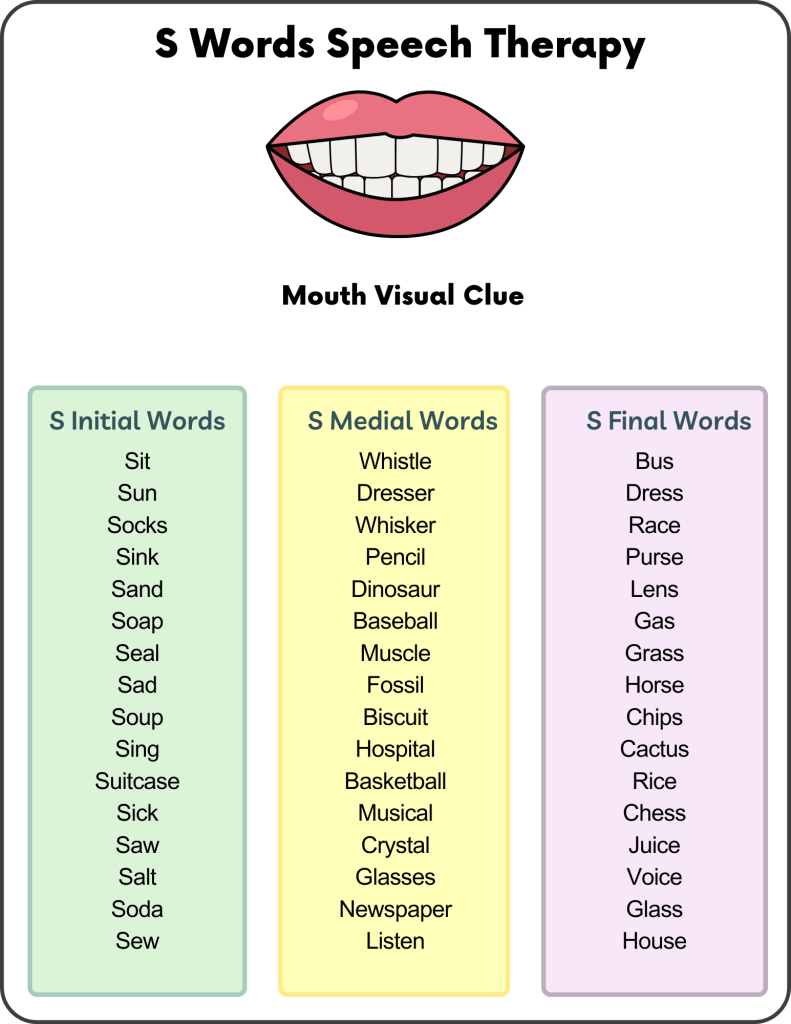L Words in Speech Therapy
November 18, 2025Introduction to S Words in Speech Therapy
Welcome, parents! If your child is working on the S sound—pronounced as in “Sit” or “Sun”—The S sound, a unvoiced alveolar fricative, is an important part of clear speech. It’s usually mastered by children between ages 5 and 6. Some children may have difficulty with this sound, often substituting it with other sounds like “th” or “sh,” or they might have a lisp. This article provides lists of S words in initial, medial, and final positions and offers tips for parents to help their children practice these words at home.

S Words Speech Therapy Printable PDF Worksheet
Understanding S Word Positions
- Initial S Words: These begin with S, like “sit” or “sun,” where the sound starts with a strong, voiced pop.
- Medial S Words: These have S in the middle, such as “whistle” or “dresser,” blending S with surrounding sounds.
- Final S Words: These end with S, like “bus” or “dress,” requiring a clear, voiced finish.
Lists of S Words for Practice
Below are curated lists of S words for each position, suitable for home use and integrated into daily activities.
S Initial Words
- Sit
- Sun
- Socks
- Sink
- Sand
- Soap
- Seal
- Sad
- Soup
- Sing
- Suitcase
- Sick
- Saw
- Salt
- Soda
- Sew
S Medial Words
- Whistle
- Dresser
- Whisker
- Pencil
- Dinosaur
- Baseball
- Muscle
- Fossil
- Biscuit
- Hospital
- Basketball
- Musical
- Crystal
- Glasses
- Newspaper
- Listen
S Final Words
- Bus
- Dress
- Race
- Purse
- Lens
- Gas
- Grass
- Horse
- Chips
- Cactus
- Rice
- Chess
- Juice
- Voice
- Glass
- House
Tips for Parents to Support Practice
Here’s how to help your child with S words at home:
- Model the Sound: Exaggerate the S sound and show how it’s made by placing the tongue close to the alveolar ridge and letting air pass through a narrow gap.
- Use Visual Aids: Use pictures or objects associated with the words to make learning more concrete.
- Make it Fun: Incorporate games or activities that involve the words, like playing “I Spy” with S words or creating a scavenger hunt for items that start with S.
- Repeat with Rhythm: Have your child repeat words multiple times to reinforce the sound.
- Use in Context: Weave words into everyday conversations or stories to provide natural practice opportunities.
- Provide Positive Feedback: Encourage and praise your child’s efforts to build confidence and motivation.
If your child continues to struggle with the S sound after practice, consider seeking help from a speech therapist for personalized guidance.. The S sound is a doorway to clear speech, and you’re ready to help your child master it! With these S initial, medial, and final word lists and easy home tips, practice can be a delight. Keep it steady and playful, and don’t hesitate to seek a professional speech therapist if needed.

